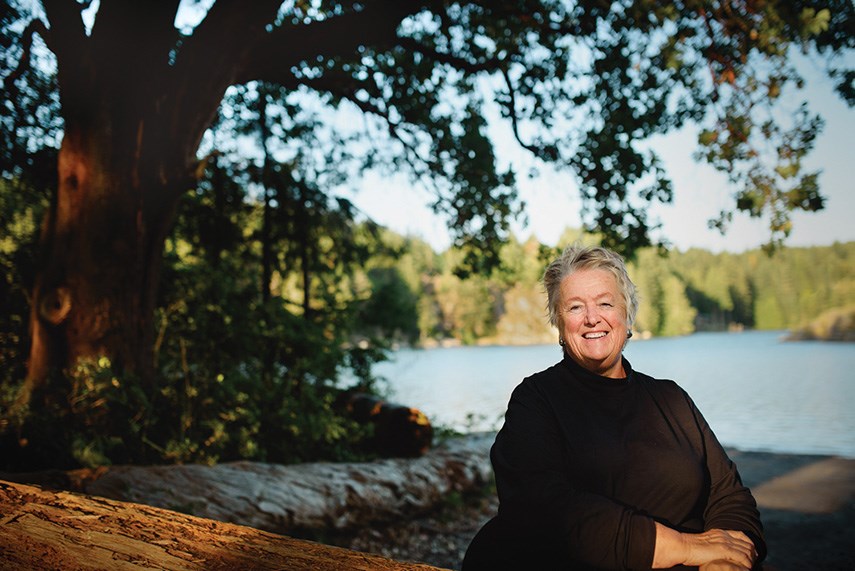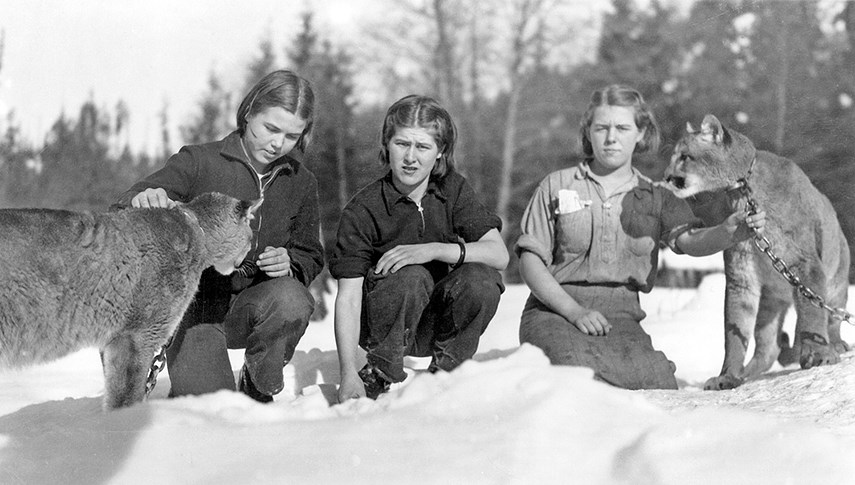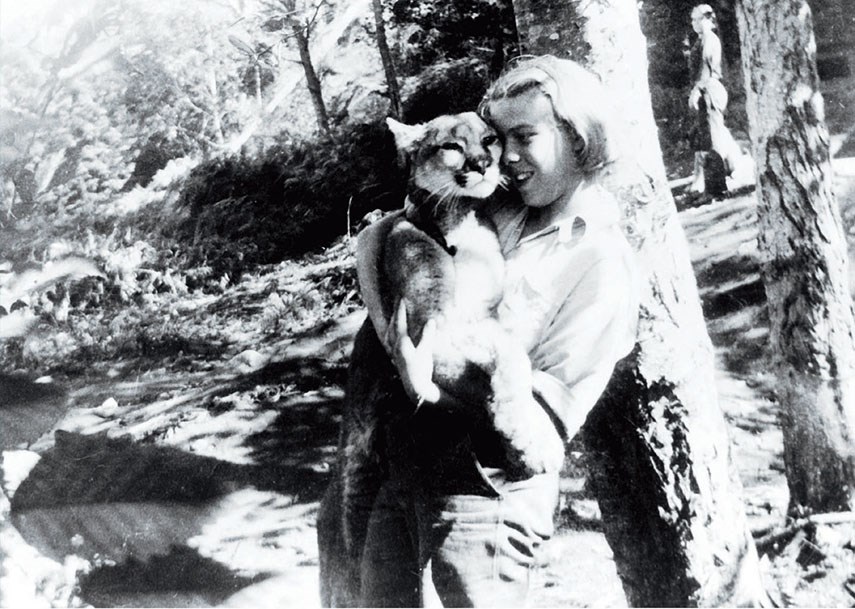Judith Williams, author of Raincoast Chronicles 24: Cougar Companions, Bute Inlet Country and the Legendary Schnarrs, talk and book signing at the Vancouver Maritime Museum, Sunday, June 2 at 2 p.m. (vancouvermaritimemuseum.com).
Historian Judith Williams has been researching and writing about her beloved Bute Inlet and the surrounding area for several decades.
High Slack: Waddington’s Gold Road and the Bute Inlet Massacre (1996), Two Wolves at the Dawn of Time (2001), Dynamite Stories (2003) and Clam Gardens (2006) are all essential reading for anyone interested in B.C. history, particularly where Indigenous cultures intersect with everything that came after them and where water meets land along the coast.
Williams, an assistant professor emeritus in UBC’s Fine Arts department, has explored the area extensively by boat. Her research gets into every nook and cranny of the region and this on the ground reconnaissance is reflected in complex, beautifully written material. Some of the books have developed out of museum exhibits she has put together on related subjects.
Her latest book, Cougar Companions, slotted in as the 24th instalment in Harbour Publishing’s ongoing B.C. history series, focuses on the hardscrabble life of logger/trapper August Schnarr who raised three daughters as a single parent on Bute Inlet in the early decades of the 20th century.
Williams talked to the North Shore News prior to her upcoming presentation at the Vancouver Maritime Museum on Sunday afternoon. The Q&A has been edited for brevity and clarity.

North Shore News: In Cougar Companions you write, “Nothing small ever happens in Bute…”
Judith Williams: It is an extraordinary place not that well known to the public, or even boaters, because of the difficulties of getting there.
North Shore News: You’ve written about the area in several books.
Judith Williams: I have, yes. I would consider myself an obsessive about Bute Inlet and the things that have happened there, the landscape and the people that I’ve learned about over the years. They’ve turned out to be pretty extraordinary, too. They are part of our history of the coast. My mother was born on Texada Island and I spent a lot of time there with her as a child with my grandparents. I was kind of an island child. I had a chance to move back to the area and I’ve spent a lot of time in the Desolation Sound area and the areas north from there.
North Shore News: How did you come across the Cougar Companions photo album? There were three copies made.
Judith Williams: I was accidentally given one copy. We have a small, but lively museum, on Cortes Island and I was doing research for an exhibition about the kind of naming process that went on with the explorers into these territories.
I got interested in the territory because I went up there to do research on Waddington’s Road. This was in the ’90s. The more I dug into the territory the more history evolved. I was talking to people and a woman said, ‘Oh, I’ve got an album of photographs of some girls who had cougars up in Bute. I will lend it to you for your research.’ The moment she did I received a very angry phone call from the son of the woman whose album it was. He was angry the album had got out of his hands. This is Glen Macklin. And then when he realized I have some depth of interest in the place he invited me to bring the album back to his mother (Pearl) and for her to talk to me.
I think she thought it was a chance to talk about her life and her point of view and then she carefully went through the album explaining all the photographs to me. Of course if you are researching anything, or trying to do something about a particular subject, finding somebody like that is just pure gold because you have a person telling you who can still remember who everybody is and where they were.
(She had) wonderful stories about the cougars themselves which were an important part of her life. The girls had a strange and interesting bond with the cougars and the cougars with the girls that was really unique. It’s thought to be unique actually by people who know a lot about cougars.
North Shore News: They treated them as pets.
Judith Williams: They certainly did and there was a circumstance that allowed this to happen. Their father had killed the mother of the cougars. He was hunting for cougars for bounty, which was one of his only sources of hard cash during the ’30s, and when he realized there were brand newborn kittens he took them home. They were blind as kittens are and so they imprinted, as we know this happens with animals, that they imprint with the first thing they see. The cougars never saw a female cougar when they opened their eyes, they saw the girls and because the girls cared for them like a mother that’s all the cougars knew. The father probably knew this – he was very knowledgeable about animals and realized that’s what would happen.
North Shore News: August Schnarr documented a lot of their lives with his Kodak 3. You suggest he bought it on his way north through Vancouver.
Judith Williams: I think so. I have the camera on loan. It looks like the camera was made in 1910. The Kodak 3 was considered the portable of its day although there ended up being a Kodak 2, which was smaller. I don’t know why he got it. It seems an odd expense for somebody like him but I think he was truly interested in photography. He carted this thing around. It was a nuisance. He had to protect it and look after it in rough circumstances.
North Shore News: Considering the remoteness of the family life there’s an incredible amount of documentation.
Judith Williams: Yes, there’s even tax forms. there’s a lot of stuff there. I could write a whole other book about the fonds themselves and what it tells you about living that life. I was very excited to find so much material, I don’t think I would have done the book. When I did the exhibition at the Cortes Museum, the Campbell River Museum asked me to move it and expand it to their museum which is quite a bit larger. I learned more and more about the photographs and what was in the files. By the time I’d done that I knew there was a book there.
North Shore News: In some of the photos it looks like August Schnarr created a floating village on the water.
Judith Williams: Hand-logging was largely a Canadian occupation and it was kind of a freebooting time. You applied for a license and were very firmly restricted in what you could use in the way of equipment. No power equipment at all. This is prior to chain saws and things like that. Because the plots that you got to log you basically had to fall the logs into the water because you didn’t have any equipment to do much else so people tended to live on these floathouse complexes all up and down the coast.
There were still such things when I moved up into the Desolation Sound area (in the early ’70s). We saw one of these floating encampments and then up in the Broughton Archipelago there’s whole little villages that are on stilts, still. Shoall Bay is like that and a few other places up in that territory.
There’s whole little communities that live on floats and, of course, the trick was you didn’t need to own any land and because you were moving your work from job to job you want to be mobile. There’s certainly houses on this island that are old floathouses that were moved on to land and ended up staying there. Some people moved their floathouses on land, others just stayed floating. They had their gardens on floats, they had their chickens on floats, everything on floats. And then when you were finished you hired a tug and got the whole thing towed somewhere else. Sometimes you had your own boat and you could do it yourself.

North Shore News: In this book and in previous works you provide a lot of detail on Indigenous history. Did Schnarr operate completely within Homalko territory or did he also go into Tŝilhqot’in territory as well?
Judith Williams: It’s a funny interface territory. The Tŝilhqot’in claim down into the Homalko Valley into the territory where the Tŝilhqot’in killed some of the road crew. They claim that they used to go down there and there’s some justification for that. When Waddington sent Robert Humphrey up to survey for his road in 1861 he encountered Tŝilhqot’in living in what are considered to be Homalko underground houses, just above the canyon. It does seem the Tŝilhqot’in came down looking for fish to dry for the winter, sometimes would get caught and spend the winter down there both in the Hamathko River Valley area and in the Southgate. There were these trails into both river valleys and it looks like those trails would be thousands of years old and were used both by the Tŝilhqot’in coming down and Homalko going up.
North Shore News: Was there much interaction between the Schnarrs and the Indigenous populations?
Judith Williams: There was quite a bit of interaction. According to Pansy they grew a lot of berries but they also picked wild berries and made a lot of jam. They didn’t have money for sugar so they found other ways of sweetening and reducing it down and they often traded jam for fish with the First Nations up there. There was one particular couple, the woman made baskets and Pansy’s mom bought baskets off her or traded something. There’s a few baskets in the Campbell River Museum that belong to the Schnarr family that are from the Homalko. I think there was a lot of trade in fish. Especially when they had the cougars because they ate a lot of fish.
Judith Williams publications:
2003 - Salmon Stock, catalogue, Richmond Art Gallery & Gulf of Georgia Cannery National Historic Site
2003 - Dynamite Stories, New Star Books, Transmontanus, Vancouver.
2001 - Two Wolves at the Dawn of Time: Kingcome Inlet Pictographs 1863-1989, New Star Books, Vancouver.
1994 – “The Tsilhqot’in War of 1864 & 1993 Cariboo-Chilcotin Justice Inquiry”, UBC Museum of Anthropology pub.
- Walking To Water, catalogue, Vancouver Art Gallery.
1990 - Whose Story Is This?, the Surrey Art Gallery, 1990.



